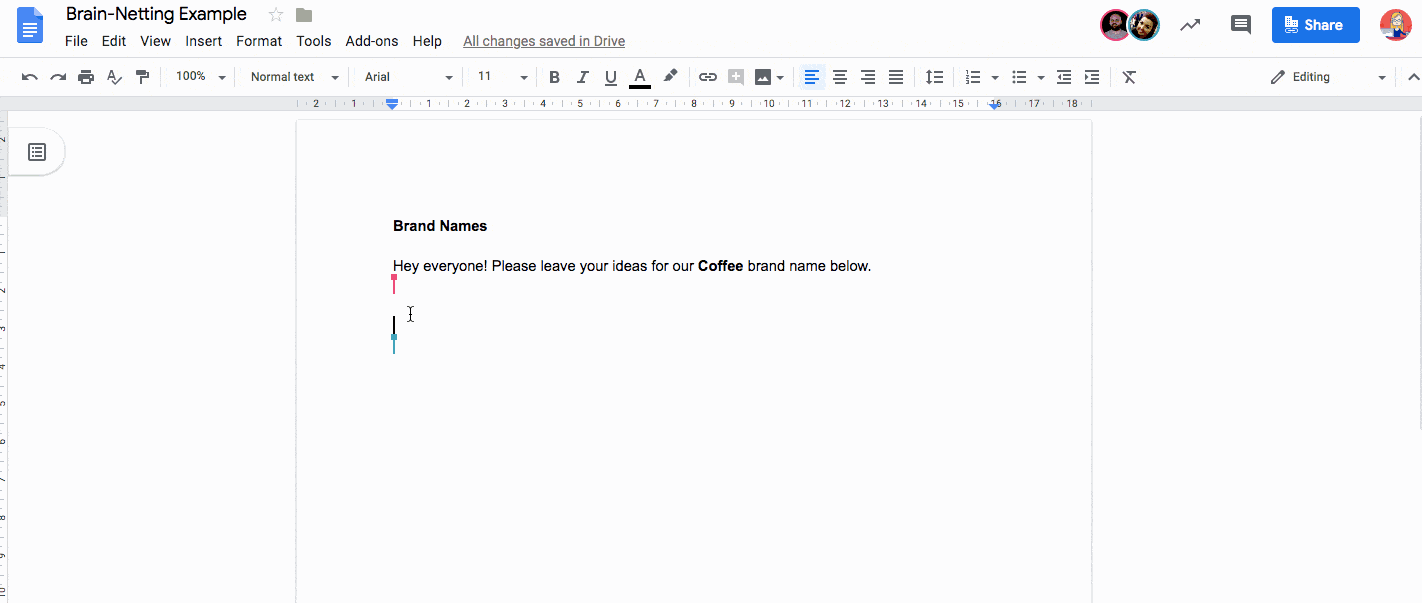Last updated on 8th March 2024
Brainstorming is a powerful tool that can help you generate fresh and innovative ideas, and it’s not just for artists and writers.
Brainstorming can be used in any field, from marketing to engineering, to come up with unique solutions and creative strategies.
We’ve put together a list of nine fun and effective brainstorming techniques that will help you unleash your creativity and generate great ideas regardless of what industry you’re in, all while having a bit of fun along the way!
So, grab a cup of coffee, clear your mind, and get ready to have some fun while learning how to come up with amazing ideas!
1. Brain writing

Brain writing is a silent activity that is great for making sure your team members aren’t influenced by each other’s ideas. It’s also perfect for ensuring that introverted members of the group actively contribute to the discussion – as there’s no pressure to raise their hand or speak in front of others.
Brain writing is great because it allows you to avoid ‘Groupthink’ – a psychological phenomenon in which a group’s desire for harmony results in a dysfunctional decision-making outcome.
In other words, everyone agrees with the first idea proposed (even if they don’t particularly think it’s the best idea) because they don’t want to ‘rock the boat.’
Brain writing ensures you’re using the best idea available, as opposed to everyone agreeing with each other to make things easier or get out of the meeting room faster!
2. Round robin

Similar to brain writing, round robin brainstorming is another way to ensure that everyone’s ideas are heard. The only difference is, round robin is a group activity and ideas are given verbally.
Invite your team into a meeting room and ask them to sit or stand in a circle. Then go around the circle and ask everyone to voice their idea. If someone repeats an idea then you can come back to that person at the end to give them more time to think of something else.
At the end of the round robin you can start to discuss all of the ideas and decide which ones stand out and which aren’t the right fit for this particular project.
Sometimes, team meetings in which everyone has a chance to speak can get a little rowdy. Round robin brainstorming is great because it gives everyone a chance to speak without anyone else talking over them.
3. Starbursting

Usually, brainstorming is all about coming together to try to find answers. But starbursting flips this on its head and asks everyone to think of questions instead.
So, let’s say your new project is a coffee brand and you’re thinking of the best way to market to your customers. Start everyone off with a wide question:
“Who are our customers?”
Answer: “Coffee drinkers.”
Pretty straightforward, but this answer then becomes the stem for new, more detailed questions:
“What type of coffee drinkers?”
Answer: “Premium coffee lovers. Not people looking for a cheap, caffeine boost, but people who appreciate fine ingredients…”
The idea is to go on and on from here, layering more and more questions on top until you’ve covered every eventuality.
At the end of this brainstorming session, you may even have a ready-made FAQ page!
4. Mind mapping

Mind mapping is likely what most people think of when they hear the phrase ‘brainstorming.’
Mind mapping is the process of creating a diagram with your main goal, idea, or project name in the centre, and then adding to this with tasks you need to complete, other ideas you may have, and really any other project-related thoughts.
This is a really ‘old school’ technique. All you need is a sheet of paper (or a whiteboard) and some markers to get going.
It’s a great way to visually list all of the milestones you need to check off to complete your project and can even help to spark some brand new ideas.
5. Figure storming

This one’s a bit of fun!
Along with your team, think of a public figure – a celebrity, a politician, a writer. Or, maybe it’s not a public figure at all – it can be your boss, your mother, better yet, your customer!
Then approach your project with their thinking cap on. How would they solve the problems you have? What would they do? How would they react in certain situations?
By putting yourself in the mindset of someone else, you might uncover great new ideas. This is a helpful way to ‘get out of your head’ if you’re feeling stuck for ideas.
6. Rapid ideation

Rapid ideation is exactly what it sounds like – it’s thinking of as many ideas as you can, in as quick a time as possible.
To start, give your team an overview of the topic that they should be brainstorming about. Then set a timer – for whatever length of time you deem appropriate (of course, more complicated projects will require more time), and you’re off!
Team members are encouraged to write or type whatever comes to their minds, without conferring with one other, and then at the end of the time limit you can read through everyone’s ideas and start picking out the golden nuggets.
The purpose of rapid ideation is to leave no room for your brain to filter anything out – good or bad – by writing down all of your thoughts as they pop up you may be able to jiggle something loose.
7. Stepladder

If you have a small to medium-sized business, then the stepladder technique could be perfect for you. This technique allows for everyone to give their opinions without any influence from others beforehand.
Like with all of the brainstorming techniques, start by informing everyone of the topic at hand. Then send everyone but one person away to think of ideas. The two people left in the room (you and one team member) will brainstorm together until satisfied, and then one person is added back into the room.
This new person is invited to share their ideas first and will then be briefed on the ideas of the people already in the room. So they cannot be influenced by the previous brainstorming, because they weren’t there.
This process is repeated until everyone has shared their ideas and is back in the room.
As you can probably guess, the reason we suggested this for smaller businesses is because it can get a bit chaotic with lots of people!
8. Collaborative brain writing

Collaborative brain writing is very similar to the brain writing mentioned above – as you can probably guess by the name!
Collaborative brain writing is the process of everyone on your team writing down ideas as they come to them. You simply stick a piece of paper up in the office, or a whiteboard, and ask team members to contribute throughout the week with their different ideas.
At the end of the week, you can then collate these ideas and go through them independently, or with the rest of the team.
Collaborative brain writing differs to traditional brain writing because everyone can see the ideas that have been suggested. It also frees everyone from the pressure to think of all of their ideas in one meeting – making it perfect for those teams who hate meetings!
9. Brain-netting

Remote working is becoming more and more common, so brain-netting is for those of you who work in different locations. It’s essentially brainstorming online.
You simply create a document online and give your team access to it. They can then contribute their ideas wherever they are and whenever they are working.
Google Drive is great for this as it allows teams to collaborate on the same document in real-time:

And their suite of products covers everything from docs, to slides, to spreadsheets – so it can work for a number of different projects.
Final thoughts
Brainstorming is a really productive and fun way to throw around new ideas and collaboratively solve problems with your team. This is especially important in the early stages of a project.
Looking for a software to manage all of your projects? With Project.co you can chat, share files, manage tasks, and take payments all in one place. Click here to get started with a free account.



